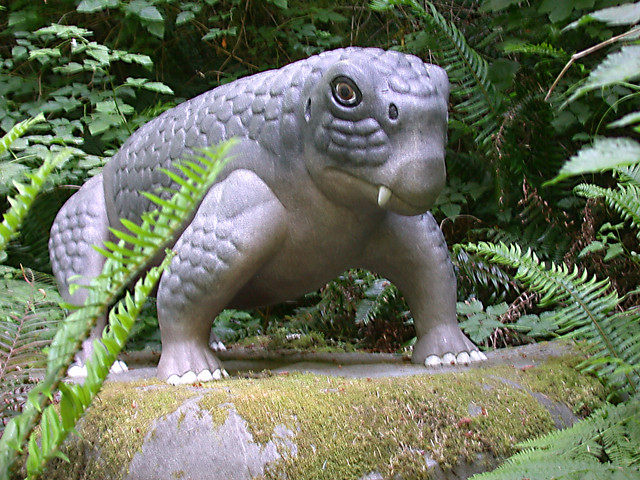05 July 2012
Fossil Vertebrate of the Month: Rutiodon carolinensis
At the end of last month, I spent a week out East, visiting the collections at the American Museum of Natural History and in Chapel Hill at a workshop that I would recommend to any geologists out there that are in the late stages of a PhD or the early stages of a postdoc. While the two states have followed very different historical trajectories, to vertebrate paleontologists New York and North Carolina have one big thing in common. The Newark Supergroup is a series of Late Triassic and Early Jurassic formations that run from Nova Scotia to the Carolinas; representing a wet, seasonal rift valley environment, these rocks are among the best places in the world to find fossils from early in the "Age of Dinosaurs" (and certainly the best in North America outside of the red beds of the Southwest). Pictured above is perhaps the most iconic fossil from the Newark Supergroup, the phytosaur Rutiodon carolinensis. Any student that's ever taken a class from me will be familiar with phytosaurs, which are one of my favorite examples of convergent evolution. Superficially, members of this now-extinct group were very similar to modern crocodiles and doubtless filled a similar ecological niche (piscivores/ambush predators). However, several features of the skeleton show that they are not the direct ancestors of crocodiles (which, in the Triassic, were primarily small, agile, and land-living); the most notable of these is the placement of the nostrils above the eyes rather than at the end of the snout as is the case in alligators and crocodiles. The specimen pictured above is a historically significant one. As the species name suggests, the first Rutiodon specimens to be uncovered were found in North Carolina. One of these specimens, from a coal mine near the town of Egypt, was acquired by W.D. Matthew in 1895. He brought it back to New York, where it became the first vertebrate fossil in the collection of the American Museum of Natural History (it bears the specimen number AMNH 1), which in the subsequent decades would grow to become the largest collection of fossil vertebrates in the world.
12 March 2012
Fossil Vertebrate of the Month: Panthera atrox
 |
| P. atrox in the Natural History Museum of L.A. County John Orcutt, 2010 |
01 February 2012
Fossil Vertebrate of the Month: Nothrotheriops
 |
| Nothrotheriops in the Nevada State Museum, Las Vegas John Orcutt, 2011 |
09 January 2012
Fossil Vertebrate of the Month - Lystrosaurus
One hundred years ago this month - on January 6th, 1912 - Alfred Wegener presented his idea that the continents had once all been joined (in a supercontinent he termed Pangaea) and were slowly floating apart as part of a process he called continental drift. His hypothesis was largely derided at the time, but would eventually evolve into plate tectonics, which is now the unifying theory of geology. Numerous lines of evidence were brought together to establish the validity of plate tectonics, but among the most convincing was the presence of remarkably similar fossils on distant continents. Perhaps the most famous of these organisms was the Permo-Triassic dicynodont Lystrosaurus. First described from South Africa, the discovery of Lystrosaurus fossils in Antarctica in the 1960s showed beyond a reasonable doubt that the two continents must have been joined (it has subsequently been uncovered in India, East Asia, and Europe, driving home the reality of plate tectonics even further). Besides its utility as a biogeographic marker, Lystrosaurus is remarkable for being one of the few survivors of the Permian-Triassic Extinction, which, by some estimates, wiped out over 90% of life on Earth. Why it was able to survive this cataclysm and to prosper in its aftermath is something of a mystery, as in many ways Lystrosaurus is a very unimpressive animal (they are often referred to as the pigs of the Triassic). In fact, my original dissertation project (before I was romanced by its distant mammalian relatives) was to be a test of the hypothesis that Lystrosaurus, as a burrowing animal, was adapted to the low-oxygen conditions that may have characterized the Early Triassic. In another Oregon-related note, the picture above is of a model from Prehistoric Gardens, south of Coos Bay, one of the more atmospheric and well-preserved "dinosaur parks" in the world.
Subscribe to:
Posts (Atom)

